A Review of Phytochemical and Pharmacological Studies on Galium verum L., Rubiaceae
Abstract
:1. Introduction
2. Materials and Methods
3. Results and Discussion
3.1. Phytochemical Composition and Biological Activity of Galium Species
3.2. Phytochemical Composition, Biological Activity, and Pharmacological Effects of G. verum
3.2.1. Content of Phenolic Compounds (Flavones, Flavonols, Flavone Glycosides, Flavonol Glycosides, Phenolic Acids) and Antioxidant Activity
3.2.2. Content of Iridoid Glycosides
3.2.3. Content of Anthraquinones
3.2.4. Content of Terpenoids (Monoterpenoids, Sesquiterpenoids, Triterpenoids, Triterpenoid Saponins) and Volatile Organic Compounds (VOCs)
3.2.5. Phytosterol Content
3.2.6. Pharmacological Effects of G. verum
3.3. Relationship Between Bioactive Compounds, Biological Activities, and Medicinal Uses
4. Relevance of the Topic and Current Research Trends
5. Conclusions
6. Future Directions
Author Contributions
Funding
Institutional Review Board Statement
Informed Consent Statement
Data Availability Statement
Conflicts of Interest
References
- Bungau, S.G.; Popa, V.-C. Between Religion and Science: Some Aspects Concerning Illness and Healing in Antiquity. Transylv. Rev. 2015, 26, 3–19. Available online: https://www.researchgate.net/publication/286442576_Between_Religion_and_Science_Some_Aspects_Concerning_Illness_and_Healing_in_Antiquity (accessed on 10 March 2025).
- Davis, C.C.; Choisy, P. Medicinal plants meet modern biodiversity science. Curr. Biol. 2024, 34, R158–R173. [Google Scholar] [CrossRef] [PubMed]
- Delprete, P.G.; Jardim, J.G. Systematics, taxonomy and floristics of Brazilian Rubiaceae: An overview about the current status and future challenges. Rodriguésia 2012, 63, 101–128. [Google Scholar] [CrossRef]
- Esguerra, J.D.; Bernardo, J.M.; Gimao, K.M.; Peralta, M.E.; Tiu, C.J.; Hernandez, G.G.; Alejandro, G.J.; Tan, M.A. Mechanism-based antioxidant activity of Rubiaceae species collected from Ilocos Norte, Philippines. Not. Sci. Biol. 2024, 16, 2. [Google Scholar] [CrossRef]
- Heitzman, M.E.; Neto, C.C.; Winiarz, E.; Vaisberg, A.J.; Hammond, G.B. Ethnobotany, phytochemistry and pharmacology of Uncaria. Phytochemistry 2025, 66, 5–29. [Google Scholar] [CrossRef]
- Martins, D.; Nunez, C.V. Secondary Metabolites from Rubiaceae Species. Molecules 2015, 20, 13422–13495. [Google Scholar] [CrossRef]
- Maldonado, C.; Barnes, C.J.; Cornett, C.; Holmfred, E.; Hansen, S.H.; Persson, C.; Antonelli, A.; Rønsted, N. Phylogeny predicts the quantity of antimalarial alkaloids within the iconic yellow Cinchona bark (Rubiaceae: Cinchona calisaya). Front. Plant Sci. 2017, 8, 391. [Google Scholar] [CrossRef] [PubMed]
- Sanders, J.P.; Dawson, W.T. Efficacy of quinidine in malaria. J. Am. Med. Assoc. 1932, 99, 1773–1777. [Google Scholar] [CrossRef]
- Mekonnen, B.; Cizungu, L.; Alegre, J.; Blondeel, H.; De Lombaerde, E.; Verbeeck, H.; Duchateau, L.; Schrevens, E.; Verheyen, K.; Boeckx, P.; et al. Smallholder farmers’ knowledge on management of Cinchona in the Democratic Republic of the Congo. Plant Ecol. Evol. 2025, 158, 3–13. [Google Scholar] [CrossRef]
- Robbrecht, E. Tropical Woody Rubiaceae. In Opera Botanica Belgica; National Botanic Garden of Belgium: Meies, Belgium, 1988; Volume 1, pp. 599–602. [Google Scholar] [CrossRef]
- Bremer, B.; Andreasen, K.; Olsson, D. Subfamilial and tribal relationships in the Rubiaceae based on rbcL sequence data. Ann. Mo. Bot. Gard. 1995, 82, 383–397. [Google Scholar] [CrossRef]
- Bremer, B. A review of molecular phylogenetic studies of Rubiaceae. Ann. Mo. Bot. Gard. 2009, 96, 4–26. [Google Scholar] [CrossRef]
- Yang, L.E.; Meng, Y.; Peng, D.L.; Nie, Z.L.; Sun, H. Molecular Phylogeny of Galium L. of the Tribe Rubieae (Rubiaceae)—Emphasis on Chinese Species and Recognition of a New Genus Pseudogalium. Mol. Phylogenet. Evol. 2018, 126, 221–232. [Google Scholar] [CrossRef] [PubMed]
- Turcov, D.; Barna, A.S.; Trifan, A.; Blaga, A.C.; Tanasa, A.M.; Suteu, D. Antioxidants from Galium verum as Ingredients for the Design of New Dermatocosmetic Products. Plants 2022, 11, 2454. [Google Scholar] [CrossRef]
- Mavi, A.; Terzi, Z.; Özgen, U.; Yildirim, A.; Coşkun, M. Antioxidant properties of some medicinal plants: Prangos ferulacea (Apiaceae), Sedum sempervivoides (Crassulaceae), Malva neglecta (Malvaceae), Cruciata taurica (Rubiaceae), Rosa pimpinellifolia (Rosaceae), Galium verum subsp verum (Rubiaceae), Urtica dioica (urticaceae). Biol. Pharm. Bull. 2004, 27, 702–705. [Google Scholar] [CrossRef]
- Tamas, M.; Stana, D.; Timis, S. Comparative phytochemical research of Galium verum L. and G. mollugo L. Not. Bot. Hort. Agrobot. 2006, 34, 18–20. [Google Scholar]
- Zhao, C.C.; Shao, J.H.; Li, X.; Kang, X.D.; Zhang, Y.W.; Meng, D.L.; Li, N. Flavonoids from Galium verum L. J. Asian Nat. Prod. Res. 2008, 10, 613–617. [Google Scholar] [CrossRef] [PubMed]
- Zhao, C.C.; Shao, J.H.; Cao, D.; Zhang, Y.W.; Li, X. Chemical constituents of Galium verum. China J. Chin. Mater. Medica. 2009, 34, 2761–2764. Available online: https://pesquisa.bvsalud.org/portal/resource/pt/wpr-315368 (accessed on 16 November 2024).
- Lakic, N.S.; Mimica-Dukic, N.M.; Isak, J.M.; Bozin, B.N. Antioxidant properties of Galium verum L. (Rubiaceae) extracts. Centr. Eur. J. Biol. 2010, 5, 331–337. [Google Scholar] [CrossRef]
- Kim, D.K. Superoxide Quenching Activity of Phenolic Compounds from the Whole Plant of Galium verum var. asiaticum. Nat. Prod. Sci. 2011, 17, 261–266. Available online: https://koreascience.kr/article/JAKO201111436239799.page (accessed on 16 November 2024).
- Zhao, R.; Chen, Z.; Jia, G.; Li, J.; Cai, Y.; Shao, X. Protective effects of diosmetin extracted from Galium verum L. on the thymus of U14-bearing mice. Can. J. Physiol. Pharmacol. 2011, 89, 665–673. [Google Scholar] [CrossRef]
- Danila, A.O.; Gatea, F.; Radu, G.L. Polyphenol composition and antioxidant activity of selected medicinal herbs. Chem. Nat. Comp. 2011, 47, 22–26. [Google Scholar] [CrossRef]
- Vlase, L.; Mocan, A.; Hanganu, D.; Benedec, D.; Gheldiu, A.; Crișan, G. Comparative study of polyphenolic content, antioxidant and antimicrobial activity of four Galium species (Rubiaceae). Dig. J. Nanomater. Biostruct. 2014, 9, 1085–1094. Available online: https://www.researchgate.net/publication/266208237 (accessed on 16 November 2024).
- Moţ, A.C.; Coman, C.; Miron, C.; Damian, G.; Sarbu, C.; Silaghi-Dumitrescu, R. An assay for pro-oxidant reactivity based on phenoxyl radicals generated by laccase. Food Chem. 2014, 143, 214–222. [Google Scholar] [CrossRef] [PubMed]
- Matei, A.O.; Gatea, F.; Radu, G.L. Analysis of phenolic compounds in some medicinal herbs by LC-MS. J. Chromatogr. Sci. 2015, 53, 1147–1154. [Google Scholar] [CrossRef]
- Layali, I.; Ebrahimzadeh, M.A.; Joulaei, M. Antioxidant properties of Galium verum. J. Life Sci. Pharm. Res. 2016, 6, L31–L37. Available online: https://www.ijlpr.com/index.php/journal/article/view/380/264 (accessed on 16 November 2024).
- Dong, J.M.; Ma, Y.L.; Zhang, Z.Y.; Li, R.; Zhu, Y.L.; Ma, L. Effects and related mechanism of flavone from Galium verum L. on peroxide induced oxidative injury in human umbilical vein endothelial cells. Zhonghua Xin Xue Guan Bing Za Zhi 2016, 44, 610–615. [Google Scholar] [CrossRef]
- Ilyina, T.V.; Goryacha, O.V.; Kovaleva, A.M.; Koshovyi, O.M.; Shynkovenko, I.L. A comparative study of morphological features and flavonoid composition of Galium L. genus species. Der. Pharm. Lett. 2016, 8, 316–320. Available online: https://www.researchgate.net/publication/316888969_A_comparative_study_of_morphological_features_and_flavonoid_composition_of_galium_L_genus_species (accessed on 16 November 2024).
- Cheng, C.; Zhang, H.; Li, Y.; Zhou, Y.; Lu, W.; Yao, L. The effect of Diosmin on the blood proteome in a rat model of venous thrombosis. Int. J. Biol. Macromol. 2017, 104, 778–787. [Google Scholar] [CrossRef]
- Kuhtinskaja, M.; Vaher, M. Extraction and Analysis of Bioactive Compounds from Dipsacus Fullonum and Galium Verum for Lyme Borreliosis Treatment. Biomed. J. Sci. Tech. Res. 2018, 11, 8614–8616. [Google Scholar] [CrossRef]
- Farcas, D.A.; Mot, C.A.; Zagrean-Tuza, C.; Toma, V.; Cimpoiu, C.; Hosu, A.; Parvu, M.; Roman, I.; Silaghi-Dumitrescu, R. Chemo-mapping and biochemical-modulatory and antioxidant/prooxidant effect of Galium verum extract during acute restraint and dark stress in female rats. PLoS ONE 2018, 13, e0200022. [Google Scholar] [CrossRef]
- Shynkovenko, I.L.; Kashpur, N.V.; Ilyina, T.V.; Kovalyova, A.M.; Goryacha, O.V.; Koshovyi, O.M.; Kryvoruchko, O.V.; Komissarenko, A.M. The immunomodulatory activity of ethanolic extracts from Galium verum L. herb. Ceska Slov. Farm. 2018, 67, 101–106. [Google Scholar] [CrossRef]
- Friščić, M.; Štibrić Baglama, M.; Milović, M.; Hazler Pilepić, K.; Maleš, Ž. Content of Bioactive Constituents and Antioxidant Potential of Galium L. Species. Croat. Chem. Acta 2018, 91, 411–417. [Google Scholar] [CrossRef]
- Hanganu, D.; Burtescu, R.F.; Petrescu, S.; Pripon Furtuna, F.R.; Chișe, E.; Turcuș, V.; Benedec, D.; Oniga, I.; Olah, N.K. Galium Species—Polyphenolic Content And Their Antioxidant Potential, Hop Med. Plants 2019, 26, 85–94. [Google Scholar] [CrossRef]
- Vuletic, M.; Jakovljevic, V.; Zivanovic, S.; Papic, M.; Papic, M.; Mladenovic, R.; Zivkovic, V.; Srejovic, I.; Jeremic, J.; Andjic, M.; et al. The Evaluation of Healing Properties of Galium verum-Based Oral Gel in Aphthous Stomatitis in Rats. Molecules 2022, 27, 4680. [Google Scholar] [CrossRef]
- Ohindovschi, A.; Cojocaru-Toma, M. Identification of phenolic compounds from extract of Galium verum. Institute of Chemistry of the Academy of Sciences of Moldova. In New Frontiers in Natural Product Chemistry; Instrumentul Bibliometric National: Chișinău, Moldova, 2023; p. 28. [Google Scholar] [CrossRef]
- Laanet, P.R.; Saar-Reismaa, P.; Jõul, P.; Bragina, O.; Vaher, M. Phytochemical Screening and Antioxidant Activity of Selected Estonian Galium Species. Molecules 2023, 28, 2867. [Google Scholar] [CrossRef]
- Antoniak, K.; Studzińska-Sroka, E.; Szymański, M.; Dudek-Makuch, M.; Cielecka-Piontek, J.; Korybalska, K. Antiangiogenic, Anti-Inflammatory and Antioxidant Properties of Bidens Tripartite Herb, Galium Verum Herb and Rumex Hydrolapathum Root. Molecules 2023, 28, 4966. [Google Scholar] [CrossRef]
- Rashed, A.; Mohamed, A.S.; Soliman, A. Ameliorative Effect of Galium Verum (Rubiaceae Family) Methanolic Extract on Folic Acid-Induced Acute Kidney Injury in Male Rats. Iraqi J. Pharm. Sci. 2023, 32, 14–24. [Google Scholar] [CrossRef]
- Razzivina, V.; Vasiljeva, A.; Kronberga, A.; Skudrins, G.; Nakurte, I.; Zogota, M.; Mezaka, I.; Pugovics, O.; Grinberga, S.; Dambrova, M.; et al. Phenolic Content and Anti-Inflammatory Activity of Cultivated and Wild-Type Galium odoratum Extracts in Murine Bone Marrow-Derived Macrophages. Antioxidants 2024, 13, 1447. [Google Scholar] [CrossRef]
- Wu, R.; Zhang, Z.; Qin, J.; Wu, Y.; Yang, F.; Li, J.; Yao, H.; Li, Y. Chemical constituents from Galium aparine and their chemotaxonomic significance. Biochem. Syst. Ecol. 2025, 119, 104943. [Google Scholar] [CrossRef]
- Ilyina, T.; Kashpur, N.; Granica, S.; Bazylko, A.; Shinkovenko, I.; Kovalyova, A.; Goryacha, O.; Koshovyi, O. Phytochemical Profiles and In Vitro Immunomodulatory Activity of Ethanolic Extracts from Galium aparine L. Plants 2019, 8, 541. [Google Scholar] [CrossRef]
- Corrigan, D.; Timoney, R.F.; Donnelly, D.M. Iridoids and alkanes in twelve species of Galium and Asperula. Phytochemistry 1978, 17, 1131–1133. [Google Scholar] [CrossRef]
- Bojthe-Horvath, K.; Hetenyi, F.; Kocsis, A.; Szabo, M.; Varga-Balázs, M.; Mathe, I.J.; Tetenyi, P. Iridoid glycosides from Galium verum L. Phytochemistry 1980, 21, 2917–2919. [Google Scholar] [CrossRef]
- Böjthe-Horváth, K.; Kocsis, A.; Párkány, L.; Simon, K. A new iridoid glycoside from Galium verum L. First X-ray analysis of a tricyclic iridoid glycoside. Tetrahedron Lett. 1982, 23, 965–966. [Google Scholar] [CrossRef]
- Mitova, M.I.; Anchev, M.E.; Handjieva, N.V.; Popov, S.S. Iridoid patterns in Galium L. and some phylogenetic considerations. Z. Nat. C 2002, 57, 226–234. [Google Scholar] [CrossRef] [PubMed]
- Demirezer, L.Ö.; Gürbüz, F.; Güvenalp, Z.; Ströch, K.; Zeeck, A. Iridoids, flavonoids and monoterpene glycosides from Galium verum subsp. Verum. Turk. J. Chem. 2006, 30, 525–534. Available online: https://journals.tubitak.gov.tr/chem/vol30/iss4/13 (accessed on 16 November 2024).
- Lee, T.G.; Kim, D.K. Iridoid Compounds from the Whole Plant of Galium verum var. asiaticum. Nat. Prod. Sci. 2013, 19, 227–230. Available online: https://koreascience.or.kr/article/JAKO201330951777064.page (accessed on 16 November 2024).
- Camero, C.M.; Germanò, M.P.; Rapisarda, A.; D’Angelo, V.; Amira, S.; Benchikh, F.; Braca, A.; De Leo, M. Anti-angiogenic activity of iridoids from Galium tunetanum. Rev. Bras. Farmacogn. 2018, 28, 374–377. [Google Scholar] [CrossRef]
- Bradic, J.; Petkovic, A.; Tomovic, M. Phytochemical and Pharmacological Properties of Some Species of the Genus galium L. (Galium verum and Mollugo). Serb. J. Exp. Clin. Res. 2017, 1, 187–193. [Google Scholar] [CrossRef]
- Heide, L.; Leistner, E. Enzyme activities in extracts of anthraquinone-containing cells of Galium mollugo. Phytochemistry 1983, 22, 659–662. [Google Scholar] [CrossRef]
- Banthorpe, D.V.; White, J.J. Novel anthraquinones from undifferentiated cell cultures of Galium verum. Phytochemistry 1995, 38, 107–111. [Google Scholar] [CrossRef]
- Zhao, C.C.; Shao, J.H.; Li, X.; Xu, J.; Wang, J.H. A new anthraquinone from Galium verum L. Nat. Prod. Res. 2006, 20, 981–984. [Google Scholar] [CrossRef] [PubMed]
- Kanso, M.A.; Hijazi, M.A.; El-Lakany, A.; Aboul-Ela, M. Review on phytochemical constituents and pharmacological activities of genus Galium. J. Appl. Pharm. Sci. 2024, 14, 46–56. [Google Scholar] [CrossRef]
- De Rosa, S.; Mitova, M.; Handjieva, N.; Popov, S.; Anchev, M. Rivalosides A and B, two 19-oxo triterpenoid saponins from Galium rivale. J. Nat. Prod. 2000, 63, 1012–1014. [Google Scholar] [CrossRef]
- Ilyina, T.V.; Kovaleva, A.M.; Goryachaya, O.V.; Aleksandrov, A.N. Essential Oil from Galium Verum Flowers. Chem. Nat. Compd. 2009, 45, 587–588. [Google Scholar] [CrossRef]
- Shynkovenko, I.L.; Ilyna, V.T.; Kovalyova, M.A.; Goryacha, V.O.; Golembiovska, I.O.; Koshovyi, M.O. Saponins of the extracts of Galium aparine and Galium verum. Vìsnik Farm 2018, 4, 16–23. [Google Scholar] [CrossRef]
- Tava, A.; Biazzi, E.; Ronga, D.; Avato, P. Identification of the Volatile Components of Galium verum L. and Cruciata leavipes Opiz from the Western Italian Alps. Molecules 2020, 25, 2333. [Google Scholar] [CrossRef] [PubMed]
- Ciotlaus, I.; Pojar-Fenesan, M.; Balea, A. Analysis of Volatile Organic Compounds from the Aerial Parts of Medicinal Plant, Galium verum. Rev. Chim. 2020, 71, 136–144. [Google Scholar] [CrossRef]
- Tucakov, J. Healing with Plants–Phytotherapy; Culture: Beograd, Croatia, 1971; pp. 24–37. [Google Scholar]
- Li, Q.-J.; Nan, M.-L.; He, Y.-F.; Wang, L.-P.; Zhao, Y.-W. Analysis of Galium verum L. SPE-CO₂ Extract by GC-MS. Med. Plant 2010, 1, 5–6. Available online: https://www.cabidigitallibrary.org/doi/pdf/10.5555/20113129801 (accessed on 16 November 2024).
- Mocan, A.; Crişan, G.; Vlase, L.; Ivănescu, B.; Bădărău, A.S.; Arsene, A.L. Phytochemical investigations on four Galium species (Rubiaceae) from Romania. Farmacia 2016, 64, 95–99. Available online: https://farmaciajournal.com/arhiva/201601/art-15-Mocan_95-99.pdf (accessed on 16 November 2024).
- Feijoo-Siota, L.; Rama, J.L.R.; Sánchez-Pérez, A.; Villa, T.G. Expression, activation and processing of a novel plant milk-clotting aspartic protease in Pichia pastoris. J. Biotechnol. 2018, 268, 28–39. [Google Scholar] [CrossRef]
- Lee, S.-Y.; Park, S.-Y.; Park, H.-J. Immuno-Enhancing Effects of Galium aparine L. in Cyclophosphamide-Induced Immunosuppressed Animal Models. Nutrients 2024, 16, 597. [Google Scholar] [CrossRef] [PubMed]
- Schmidt, M.; Polednik, C.; Roller, J.; Hagen, R. Galium verum aqueous extract strongly inhibits the motility of head and neck cancer cell lines and protects mucosal keratinocytes against toxic DNA damage. Oncol. Rep. 2014, 32, 1296–1302. [Google Scholar] [CrossRef] [PubMed]
- Schmidt, M.; Scholz, C.; Gavril, G.; Otto, C.; Polednik, C.; Roller, J.; Hagen, R. Effect of Galium verum aqueous extract on growth, motility and gene expression in drug-sensitive and -resistant laryngeal carcinoma cell lines. Int. J. Oncol. 2014, 44, 745–760. [Google Scholar] [CrossRef]
- Khalili, M.; Ebrahimzadeh, M.A.; Safdari, Y. Antihaemolytic activity of thirty herbal extracts in mouse red blood cells. Arh. Za Hig. Rada I Toksikologiju 2014, 65, 399–406. [Google Scholar] [CrossRef]
- Goryacha, O.V.; Ilyina, T.V.; Kovalyova, A.M.; Koshovyi, O.M.; Krivoruchko, O.V.; Vladimirova, I.M.; Komisarenko, A.M. A hepatoprotective activity of Galium verum L. extracts against carbon tetrachloride-induced injuri in rats. Der Pharma Chem. 2017, 7, 80–83. Available online: http://www.derpharmachemica.com/archive.html (accessed on 16 November 2024).
- Zagayko, A.L.; Briukhanova, T.O. A comparative study diuretic activity of Galium verum various extracts. Ukr. Biopharm. J. 2018, 1, 31–34. [Google Scholar] [CrossRef]
- Milevic, A.; Simic, M.; Tomovic, M.; Rankovic, M.; Jakovljevic, V.; Bradic, J. The effects of methanol extract of Galium verum L. on cardiac redox state in hypertensive rats. Braz. J. Pharm. Sci. 2022, 58, e191062. [Google Scholar] [CrossRef]
- Bradic, J.; Zivkovic, V.; Srejovic, I.; Jakovljevic, V.; Petkovic, A.; Turnic, T.N.; Jeremic, J.; Jeremic, N.; Mitrovic, S.; Sobot, T.; et al. Protective Effects of Galium verum L. Extract against Cardiac Ischemia/Reperfusion Injury in Spontaneously Hypertensive Rats. Oxid. Med. Cell. Longev. 2019, 2019, 4235405. [Google Scholar] [CrossRef]
- Bradic, J.; Andjic, M.; Novakovic, J.; Kocovic, A.; Tomovic, M.; Petrovic, A.; Nikolic, M.; Mitrovic, S.; Jakovljevic, V.; Pecarski, D. Lady’s Bedstraw as a Powerful Antioxidant for Attenuation of Doxorubicin-Induced Cardiotoxicity. Antioxidants 2023, 12, 1277. [Google Scholar] [CrossRef]
- Beirami, A.D.; Akhtari, N.; Noroozi, R.; Hatamabadi, D.; Hasan, S.M.; Ayatollahi, S.A.; Ayatollahi, N.A.; Kobarfard, F. Bringing back Galium aparine L. from forgotten corners of traditional wound treatment procedures: An antimicrobial, antioxidant, and in-vitro wound healing assay along with HPTLC fingerprinting study. BMC Complement. Med. Ther. 2024, 24, 279. [Google Scholar] [CrossRef]
- Aslantürk, S.; Çelik, T.A.; Karabey, B.; Karabey, F. Apoptotic Activities of Ethyl Acetate and Methanol Extracts of Galium aparine L. , J. Pharm. Res. Int. 2017, 15, 1–16. Available online: https://journaljpri.com/index.php/JPRI/article/view/203/406 (accessed on 16 November 2024).
- Pashapour, S.; Heshmati, M.; Mousavi, Z.; Esmaeili, S. The Apoptotic Effect of Methanolic Extract of Galium verum on HT29 Cell Line. J. Biol. Stud. 2022, 4, 210–220. [Google Scholar] [CrossRef]
- Pashapour, S.; Heshmati, M.; Mousavi, Z.; Esmaeili, S. Effect of whole methanolic extract of Galium verum on AGO cell line. Toxicol. Commun. 2022, 4, 10. [Google Scholar] [CrossRef]
- Marković, M.S.; Pljevljakušić, D.S.; Pančić, A.S.; Rakonjac, L.B.; Nikolić, B.M.; Stankov, J.V.P. Ethnobotanical use of plants from the genus Galium in the Pirot District. Pirot. Zb. 2023, 48, 191–202. [Google Scholar] [CrossRef]
- Peng, Y.; Demidchik, V.; Li, Y.; Shen, Z. Comparison of terpenoids in Nauclea officinalis and Paederia scandens and their anti-inflammatory effects on RAW264. 7 macrophages. Fitoterapia 2025, 182, 106411. [Google Scholar] [CrossRef]
- Jarić, S.; Popović, Z.; Mačukanović-Jocić, M.; Djurdjević, L.; Mijatović, M.; Karadžić, B.; Mitrović, M.; Pavlović, P. An Ethnobotanical Study on the Usage of Wild Medicinal Herbs from Kopaonik Mountain (Central Serbia). J. Ethnopharmacol. 2007, 111, 160–175. [Google Scholar] [CrossRef]
- Menković, N.; Šavikin, K.; Tasić, S.; Zdunić, G.; Stešević, D.; Milosavljević, S.; Vincek, D. Ethnobotanical study on traditional uses of wild medicinal plants in Prokletije Mountains (Montenegro). J. Ethnopharmacol. 2011, 133, 97–107. [Google Scholar] [CrossRef]
- Mitic, V.D.; Stankov-Jovanovic, V.P.; Ilic, M.D.; Vasiljevic, P.J.; Zabar, A.L.; Stojanovic, G.S. The antioxidant, hemolytic and cholinesterase inhibition properties of Galium verum L. and Tragopogon pratensis subsp. pratensis. Bulg. Chem. Commun. 2014, 46, 269–276. Available online: http://bcc.bas.bg/BCC_Volumes/Volume_46_Number_2_2014/BCC-46-2-269-276-Mitic.pdf (accessed on 16 November 2024).
- Popović, Z.; Smiljanić, M.; Matić, R.; Kostić, M.; Nikić, P.; Bojović, S. Phytotherapeutical plants from the Deliblato Sands (Serbia): Traditional pharmacopoeia and implications for conservation. Indian J. Tradit. Knowl. 2012, 11, 385–400. Available online: https://nopr.niscpr.res.in/handle/123456789/14378 (accessed on 16 November 2024).
- Ilyina, T.V.; Goryacha, O.V.; Toryanik, E.L.; Kulish, I.A.; Kovaleva, A.M. Antimicrobial Activity of the Genus Galium, L. Pharmacogn. Commun. 2016, 6, 42–47. [Google Scholar] [CrossRef]
- Semenescu, A.-D.; Moacă, E.-A.; Iftode, A.; Dehelean, C.-A.; Tchiakpe-Antal, D.-S.; Vlase, L.; Rotunjanu, S.; Muntean, D.; Chiriac, S.D.; Chioibaş, R. Recent Updates Regarding the Antiproliferative Activity of Galium verum Extracts on A375 Human Malignant Melanoma Cell Line. Life 2024, 14, 112. [Google Scholar] [CrossRef]
- Asenov, I.; Gusev, C.H.; Kitanov, G.; Nikolov, S.T.; Petkov, T. Gathering of Medicinal Plants; Biler: Sofia, Bulgaria, 1998. (In Bulgarian) [Google Scholar]
- Morariu-Briciu, D.M.; Bolintineanu, S.L.; Rata, A.; Semenescu, A.D.; Anton, A.; Jijie, R.; Kis, A.; Hrubaru, I.; Heghes, A. Assessment of the biosafety profile of Galium verum in vitro on myoblasts and in ovo on chorioallantoic membrane. World J. Cardiol. 2025, 17, 102310. [Google Scholar] [CrossRef] [PubMed]
- Markov, V. The ancient Thracian megalithic sanctuary ’Markov Kamak’ at Tsarev Peak in Rila Mountain: Semantic and functional analysis. In Geoarchaeology and Archaeomineralogy; Publishing House ‘St. Ivan Rilski’: Sofia, Bulgaria, 2008; pp. 177–179. Available online: http://satrae.swu.bg/media/5058/markovb.pdf (accessed on 16 November 2024).
- Mocan, A.; Diuzheva, A.; Bădărău, S.; Moldovan, C.; Andruch, V.; Carradori, S.; Campestre, C.; Tartaglia, A.; De Simone, M.; Vodnar, D.; et al. Liquid Phase and Microwave-Assisted Extractions for Multicomponent Phenolic Pattern Determination of Five Romanian Galium Species Coupled with Bioassays. Molecules 2019, 24, 1226. [Google Scholar] [CrossRef]
- Güvenalp, Z.; Kilic, N.; Kazaz, C.; Kaya, Y.; Demirezer, L. Chemical constituents of Galium tortumense. Turk. J. Chem. 2006, 30, 515–523. Available online: https://journals.tubitak.gov.tr/chem/vol30/iss4/12 (accessed on 16 November 2024).
- Tzakou, O.; Mylonas, P.; Vagias, C.; Petrakis, P.V. Iridoid glucosides with insecticidal activity from Galium melanantherum. Z. Naturforsch. C 2007, 62, 597–602. [Google Scholar] [CrossRef]
- Semenescu, A.D.; Moacă, E.A.; Iftode, A.; Dehelean, C.A.; Tchiakpe-Antal, D.S.; Vlase, L.; Vlase, A.M.; Muntean, D.; Chioibaş, R. Phytochemical and Nutraceutical Screening of Ethanol and Ethyl Acetate Phases of Romanian Galium verum Herba (Rubiaceae). Molecules 2023, 28, 7804. [Google Scholar] [CrossRef] [PubMed]
- Saeed, S.A.; Javed, S. Exploring the economic value of underutilized plant species in Ayubia national park. Pak. J. Botany 2007, 39, 1435–1442. Available online: https://www.researchgate.net/publication/256298201_Exploring_the_Economic_Value_of_Underutilized_Plant_Species_in_Ayubia_National_Park (accessed on 16 November 2024).
- Matejić, J.S.; Stefanović, N.; Ivković, M.; Živanović, N.; Marin, P.D.; Džamić, A.M. Traditional uses of autochthonous medicinal and ritual plants and other remedies for health in Eastern and South-Eastern Serbia. J. Ethnopharmacol. 2020, 261, 113186. [Google Scholar] [CrossRef]
- Dias, M.C.; Pinto, D.C.G.A.; Silva, A.M.S. Plant Flavonoids: Chemical Characteristics and Biological Activity. Molecules 2021, 26, 5377. [Google Scholar] [CrossRef]
- Nijveldt, R.J.; van Nood, E.; van Hoorn, D.E.C.; Boelens, P.G.; van Norren, K.; van Leeuwen, P.A.M. Flavonoids: A review of probable mechanisms of action and potential applications. Am. J. Clin. Nutr. 2001, 74, 418–425. [Google Scholar] [CrossRef]
- Kessler, M.; Ubeaud, G.; Jung, L. Anti- and pro-oxidant activity of rutin and quercetin derivatives. J. Pharm. Pharmacol. 2003, 55, 131–142. [Google Scholar] [CrossRef]
- Abdel-Daim, M.M.; Abo-El-Sooud, K.; Aleya, L.; Bungǎu, S.G.; Najda, A.; Saluja, R. Alleviation of Drugs and Chemicals Toxicity: Biomedical Value of Antioxidants. Oxidative Med. Cell. Longev. 2018, 2018, 6276438. [Google Scholar] [CrossRef]
- Abdel-Daim, M.M.; Zakhary, N.I.; Aleya, L.; Bungǎu, S.G.; Bohara, R.A.; Siddiqi, N.J. Aging, Metabolic, and Degenerative Disorders: Biomedical Value of Antioxidants. Oxidative Med. Cell. Longev. 2018, 2018, 2098123. [Google Scholar] [CrossRef] [PubMed]
- Dai, J.; Mumper, R.J. Plant Phenolics: Extraction, Analysis and Their Antioxidant and Anticancer Properties. Molecules 2010, 15, 7313–7352. [Google Scholar] [CrossRef] [PubMed]
- Arts, I.C.W.; Hollman, P.C.H. Polyphenols and disease risk in epidemiologic studies. Am. J. Clin. Nutr. 2005, 81, 317S–325S. [Google Scholar] [CrossRef] [PubMed]
- Higdon, J.V.; Frei, B. Tea Catechins and Polyphenols: Health Effects, Metabolism, and Antioxidant Functions. Crit. Rev. Food Sci. Nutr. 2003, 43, 89–143. [Google Scholar] [CrossRef]
- Yang, C.S.; Landau, J.M.; Huang, M.T.; Newmark, H.L. Inhibition of carcinogenesis by dietary polyphenolic compounds. Annu. Rev. Nutr. 2001, 21, 381–406. [Google Scholar] [CrossRef]
- Rasmussen, S.E.; Frederiksen, H.; Krogholm, K.S.; Poulsen, L. Dietary Proanthocyanidins: Occurrence, Dietary Intake, Bioavailability, and Protection against Cardiovascular Disease. Mol. Nutr. Food Res. 2005, 49, 159–174. [Google Scholar] [CrossRef]
- Hertog, M.G.L.; Feskens, E.J.M.; Hollman, P.C.H.; Katan, M.B.; Kromhout, D. Dietary flavonoids and cancer risk in the Zutphen elderly study. Nutr. Cancer 1994, 22, 175–184. [Google Scholar] [CrossRef]
- Cole, G.M.; Lim, G.P.; Yang, F.; Teter, B.; Begum, A.; Ma, Q.; Harris-White, M.E.; Frautschy, S.A. Prevention of Alzheimer’s disease: Omega-3 fatty acid and phenolic antioxidant interventions. Neurobiol. Aging 2005, 26, 133–136. [Google Scholar] [CrossRef]
- Ebrahimzadeh, M.A.; Nabavi, S.M.; Nabavi, S.F.; Bahramian, F.; Bekhradnia, A.R. Antioxidant and free radical scavenging activity of H. officinalis, L. Var. angustifolius, V. odorata, B. hyrcana and C. speciosum. Pak. J. Pharm. Sci. 2010, 23, 29–34. Available online: https://pubmed.ncbi.nlm.nih.gov/20067863/ (accessed on 16 November 2024). [PubMed]
- Ebrahimzadeh, M.A.; Hosseinimehr, S.J.; Hamidinia, A.; Jafari, M. Antioxidant and free radical scavenging activity of Feijoa sallowiana fruits peel and leaves. Pharmacologyonline 2008, 1, 7–14. Available online: https://www.researchgate.net/publication/286282080_Antioxidant_and_free_radical_scavenging_activity_of_Feijoa_sallowiana_fruits_peel_and_leaves (accessed on 16 November 2024).
- Naguib, Y.M.A. A fluorometric method for measurement of oxygen radical scavenging activity of water soluble antioxidants. Anal. Biochem. 2000, 284, 93–98. [Google Scholar] [CrossRef] [PubMed]
- Wang, C.; Gong, X.; Bo, A.; Zhang, L.; Zhang, M.; Zang, E.; Zhang, C.; Li, M. Iridoids: Research Advances in Their Phytochemistry, Biological Activities, and Pharmacokinetics. Molecules 2020, 25, 287. [Google Scholar] [CrossRef]
- Ghisalberti, E.L. Biological and pharmacological activity of naturally occurring iridoids and secoiridoids. Phytomedicine 1998, 5, 147–163. [Google Scholar] [CrossRef]
- Viljoen, A.; Mncwangi, N.; Vermaak, I. Anti-inflammatory iridoids of botanical origin. Curr. Med. Chem. 2012, 19, 2104–2127. [Google Scholar] [CrossRef]
- Dinda, B. Pharmacology and Application of Naturally Occuring Iridoids; Springer International Publishing: Berlin/Heidelberg, Germany, 2019; ISBN 9783030055752. [Google Scholar] [CrossRef]
- Harborne, J.B. Phytochemicals Methods; Chapman and Hall Ltd.: London, UK, 1973; pp. 119–120. Available online: https://books.google.bg/books?id=2yvqeRtE8CwC&lpg=PR7&ots=xBdoT8VqT8&lr&hl=bg&pg=PR10#v=onepage&q&f=false (accessed on 16 November 2024).
- Li, Y.; Jiang, J.G. Health functions and structure-activity relationships of natural anthraquinones from plants. Food Funct. 2018, 9, 6063–6080. [Google Scholar] [CrossRef]
- Qun, T.; Zhou, T.; Hao, J.; Wang, C.; Zhang, K.; Xu, J.; Wang, X.; Zhou, W. Antibacterial activities of anthraquinones: Structure–activity relationships and action mechanisms. RSC Med. Chem. 2023, 14, 1446–1471. [Google Scholar] [CrossRef] [PubMed]
- Biswas, T.; Dwivedi, U.N. Plant Triterpenoid Saponins: Biosynthesis, in Vitro Production, and Pharmacological Relevance. Protoplasma 2019, 256, 1463–1486. [Google Scholar] [CrossRef]
- Woyengo, T.A.; Ramprasath, V.R.; Jones, P.J.H. Anticancer effects of phytosterols. Eur. J. Clin. Nutr. 2009, 63, 813–820. [Google Scholar] [CrossRef]
- Shahzad, N.; Khan, W.; Shadab, M.D.; Ali, A.; Saluja, S.S.; Sharma, S.; Al-Allaf, F.A.; Abduljaleel, Z.; Ibrahim, I.A.A.; Abdel-Wahab, A.F.; et al. Phytosterols as a natural anticancer agent: Current status and future perspective. Biomed. Pharm. 2017, 88, 786–794. [Google Scholar] [CrossRef] [PubMed]
- Berkhin, E.B. Methods of studying the action of new chemical compounds on kidney function. Pharm. Chem. J. 1977, 11, 3–11. [Google Scholar] [CrossRef]
- Zahra, M.; Abrahamse, H.; George, B.P. Flavonoids: Antioxidant Powerhouses and Their Role in Nanomedicine. Antioxidants 2024, 13, 922. [Google Scholar] [CrossRef]
- Watroly, M.N.; Sekar, M.; Fuloria, S.; Gan, S.H.; Jeyabalan, S.; Wu, Y.S.; Subramaniyan, V.; Sathasivam, K.V.; Ravi, S.; Mat Rani, N.N.I.; et al. Chemistry, Biosynthesis, Physicochemical and Biological Properties of Rubiadin: A Promising Natural Anthraquinone for New Drug Discovery and Development. Drug Des. Dev. Ther. 2021, 15, 4527–4549. [Google Scholar] [CrossRef] [PubMed]
- Zhao, J.Q.; Hao, Y.Y.; Gong, T.T.; Wei, Y.F.; Zheng, G.; Du, Z.D.; Zou, B.J.; Yan, S.; Liu, F.H.; Gao, S.; et al. Phytosterol intake and overall survival in newly diagnosed ovarian cancer patients: An ambispective cohort study. Front. Nutr. 2022, 9, 974367. [Google Scholar] [CrossRef]

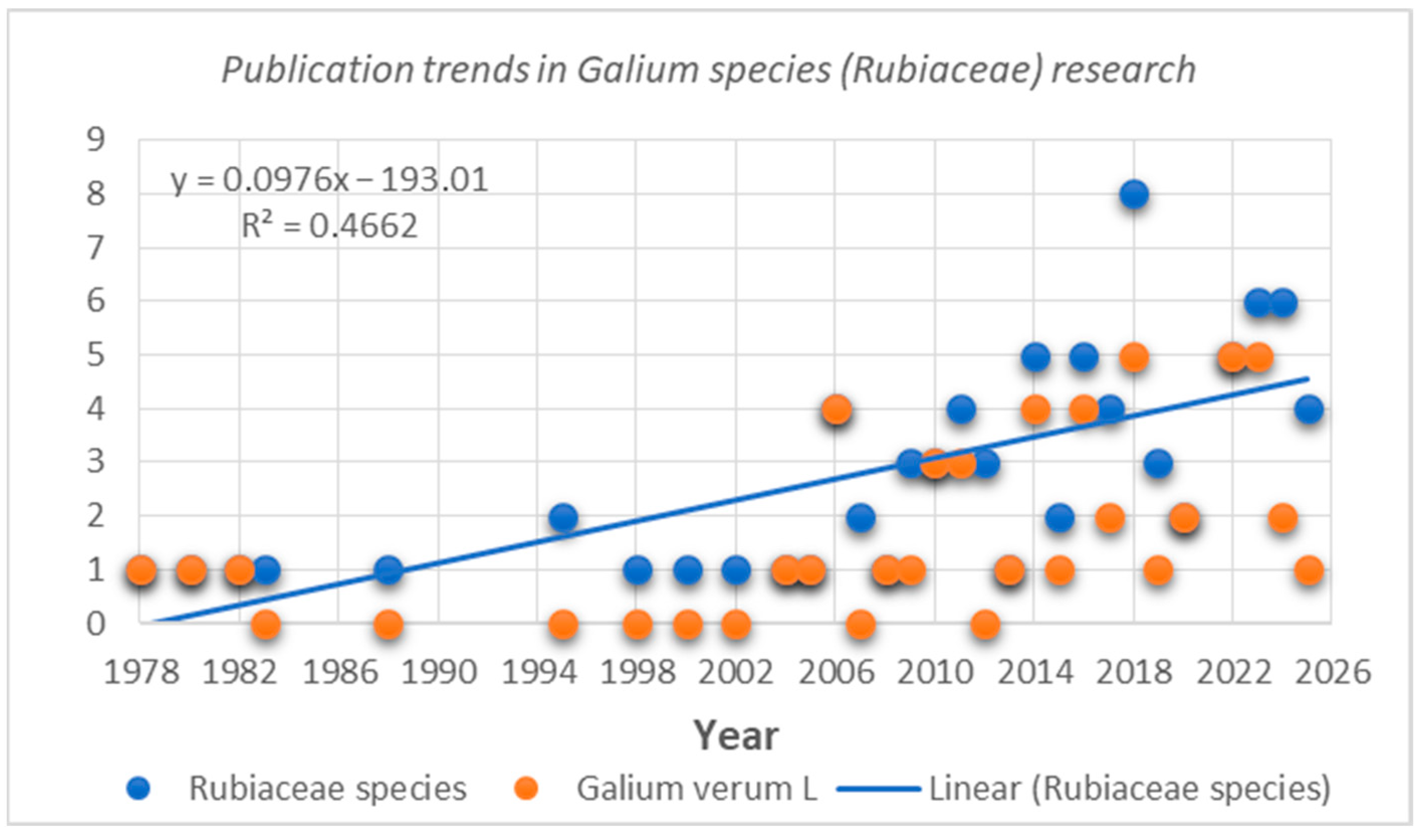
| Species | Phytochemical Group of Compounds | Compounds | Reference |
|---|---|---|---|
| G. aparine | Flavonoids | Astragalin; Hyperoside; Isorhamnetin 3-O-rhamnoglucoside; Isorhamnetin-3-O-rutinoside; Isoquercitrin; Kaempferol; Kaempferol-3-O-β-D-glucopyranosyl-7-O-α-L-rhamnopyranoside; Kaempferol-7-O-α-L-rhamnopyranoside; Luteolin; Nicotiflorin; Quercetin; Quercetin glycoside; Quercetin-3-O-β-D-glucopyranoside; Rutin | [23,28,37,42,54] |
| Polyphenols | Caffeic acid; Chlorogenic acid; Coumaric acid; Cryptochlorogenic acid; Dicaffeoylquinic acid isomer; Ferulic acid; Gallic acid; Neochlorogenic acid; p-Coumaric acid; p-Hydroxybenzoic acid; Protocatechuic acid | [23,37,41] | |
| Iridoids | 10-Desacetylasperulosidic acid; Asperuloside; Asperulosidic acid; Deacetylasperulosidic acid; Geniposide; Monotropein; Scandoside | [37,41,42,46,54] | |
| Anthraquinones | Emodin; Rhein | [41,54] | |
| Terpenoids | Betulin; Euscaphic acid; Lupeol; Oleanolic acid; Tormentic acid; Ursolic acid | [57] | |
| Phytosterols | β-Sitosterol; Campesterol | [62] | |
| G. mollugo | Flavonoids | Astragalin; Catechin; Cosmosiin; Cynaroside; Diosmetin; Diosmetin 7-O-β-D-glucopyranoside; Diosmetin 7-O-β-D-xylopyranosyl-1,6-β-D-glucopyranoside; Diosmetin isomer; Epicatechin; Hesperidin; Hispidulin; Hyperozide; Isorhamnetin; Isorhamnetin 3-O-α-L-rhamnopyranosyl-1,6-β D-glucopyranoside; Isorhoifolin; Kaempferol; Kaempferol-O-glucoside; Luteolin; Quercetin; Quercetin-3-O-β-D-glucopyranoside; Quercitrin; Rutin | [23,37,50,54] |
| Polyphenols | Caffeic acid; Chlorogenic acid; Complicatus; Cryptochlorogenic acid; Ferulic acid; Gallic acid; p-Coumaric acid; Coumaric acid | [23,28,37,50,54] | |
| Iridoids | 10-Desacetyl asperulosidic acid; 10-Hydroxyloganin; 10-Hydroxymorroniside; Asperulosidic acid; Asperuloside; Deacetylalpinoside; Deacetyl-daphylloside; Deacetylasperulosidic acid; Daphylloside; Galioside; Gardenosidic acid; Geniposidic acid; Loganin; Mollugoside; Monotropein; Scandoside; Scandoside methyl ester; Secogalioside; 6-Acetylscandoside; 6-O-epi-Acetyl scandosid | [37,42,50,54] | |
| Phytosterols | β-Sitosterol; Campesterol | [62] | |
| G. odoratum | Flavonoids | Kaempferol; Quercetin; Quercitrin; Rutin | [23,40] |
| Polyphenols | Caffeic acid; Chlorogenic acid; p-Coumaric acid; Ferulic acid | [23,40,54] | |
| Iridoids | 10-Deacetyl asperulosidic acid; Asperulosidic acid; Asperuloside; Deacetyl asperuloside; Geniposidic acid; Monotropein; Scandoside | [40,46,54] | |
| Phytosterols | β-Sitosterol; Campesterol | [54,62] | |
| G. verum | Flavonoids | Apigenin; Apigetrin; Astragalin; Catechin; Chrysin; Cynaroside; Diosmin; Diosmetin; Epicatechin; Fisetin; Hesperidin; Hyperoside; Isorhoifolin; Isorhamnetin; Isoquercetin; Isoquercitrin; Kaempferol; Luteolin; Quercetin; Quercitrin; Rutin | [16,17,18,20,21,22,23,25,28,29,35,36,37,47,48,50,52,54,84] |
| Polyphenols | Caffeic acid; Chlorogenic acid; Coumarinic acid; p-Coumaric acid; Ferulic acid; Gallic acid; | [16,20,22,23,25,35,37,50,84] | |
| Iridoids | Asperuloside; Asperulosidic acid; Daphylloside; Deacetyl-asperulosidic acid; Deacetyl-asperuloside; Geniposidic acid; Loganin; Monotropein; Scandoside | [37,46,50,54] | |
| Anthraquinones | Physcion; 1,3-Dihydroxy-2-methylanthraquinone (Rubiadin) | [53] | |
| Terpenoids | α-Terpineol; Betulalbuside A; Betulin; Borneol; Camphor; Euscaphic acid; Germacrene D; Lupeol; Oleanolic acid; Rubifolic acid; Squalene; Tormentic acid; Ursolic acid; Uvaol | [54,57] | |
| Phytosterols | β-Sitosterol; Campesterol; Stigmasterol | [61,62] |
| № | Phytochemical Compound | Molecular Formula | 2D Chemical Structure * | Biological Activity | Ref. |
|---|---|---|---|---|---|
| Flavonoids | |||||
| 1 | Apigenin | C15H10O5 | 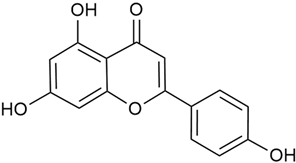 | Antioxidant | [22,36,84] |
| 2 | Apigetrin (Cosmosiin, Apigenin 7-glucoside) | C21H20O10 | 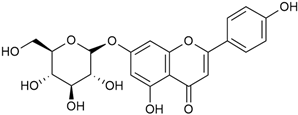 | [22,28] | |
| 3 | Astragalin (Kaempferol 3-O-glucoside) | C21H20O11 |  | [47] | |
| 4 | (+)-Catechin (Cianidanol) | C15H14O6 |  | Antioxidant Anti-inflammatory Antimicrobial | [25] |
| 5 | Chrysin | C15H10O4 | 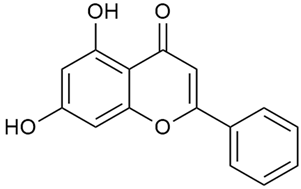 | [25] | |
| 6 | Cynaroside (Luteolin 7-O-glucoside) | C21H20O11 |  | [28] | |
| 7 | Diosmin | C28H32O15 | 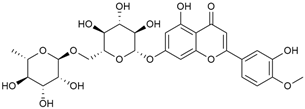 | Anti-thrombotic | [29] |
| 8 | Diosmetin | C16H12O6 | 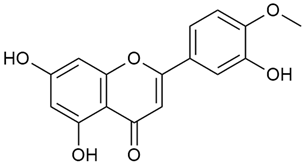 | Anticancer Antiapoptotic | [17,18,21] |
| 9 | (-)-Epicatechin | C15H14O6 | 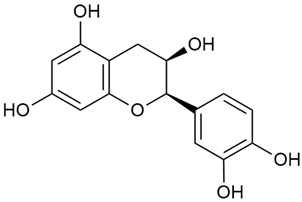 | [25,84] | |
| 10 | Fisetin | C15H10O6 | 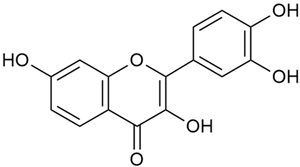 | [25] | |
| 11 | Hesperidin | C28H34O15 | 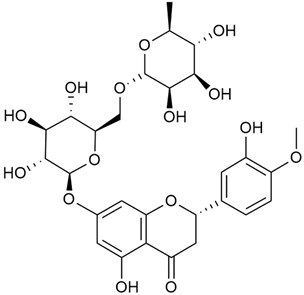 | [25] | |
| 12 | Hyperoside | C21H20O12 |  | [16,36] | |
| 13 | Isorhoifolin (Apigenin 7-O-rutinoside) | C27H30O14 |  | [28] | |
| 14 | Isorhamnetin | C16H12O7 | 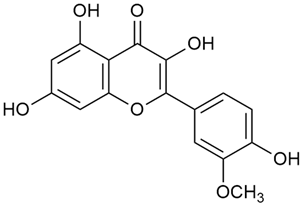 | [18] | |
| 15 | Isoquercetin | C21H20O12 | 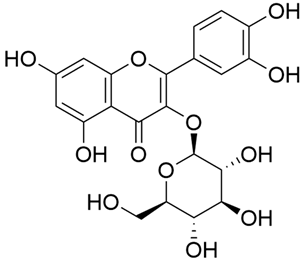 | [36] | |
| 16 | Isoquercitrin | C21H20O12 | 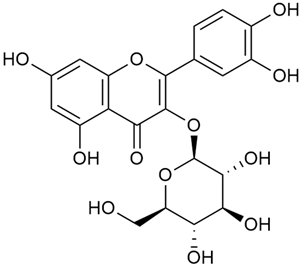 | Anticancer | [23,25,84] |
| 17 | Kaempferol | C15H10O6 |  | Antioxidant | [22,23] |
| 18 | Luteolin | C15H10O6 |  | Antioxidant | [20,22,84] |
| 19 | Quercetin | C15H10O7 | 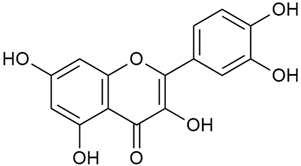 | Anti-hypertensive Anti-inflammatory | [22,35,36] |
| 20 | Quercitrin | C21H20O11 |  | Antioxidant Antimicrobial | [16,23,35,36] |
| 21 | Rutin | C27H30O16 | 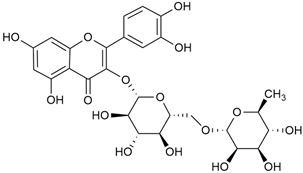 | Antioxidant Anticancer Antimicrobial | [16,20,22,35,36,47,84] |
| Phenolic acids | |||||
| 22 | Caffeic acid | C9H8O4 |  | Antioxidant | [16,20,22,25] |
| 23 | Chlorogenic acid | C16H18O9 |  | Antioxidant Anticancer Antimicrobial | [16,22,23,25,35] |
| 24 | Coumarinic acid | C9H8O3 |  | [22] | |
| 25 | p-Coumaric acid | C9H8O3 |  | Antioxidant | [22,23,25,35,84] |
| 26 | Ferulic acid | C10H10O4 | 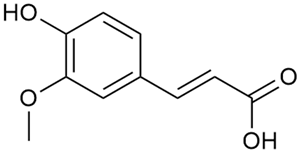 | [22,23,25,84] | |
| 27 | Gallic acid | C7H6O5 |  | [35] | |
| Iridoid glycosides | |||||
| 28 | Asperuloside | C18H22O11 | 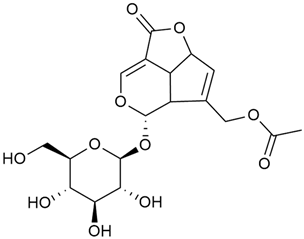 | Antioxidant Anticancer Anti-inflammatory | [46,47,48] |
| 29 | Asperulosidic acid | C18H24O12 | 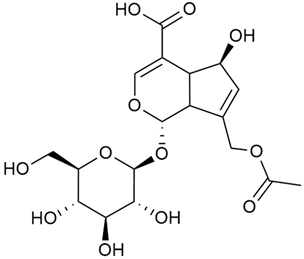 | [46,47,48] | |
| 30 | Daphylloside | C19H26O12 | 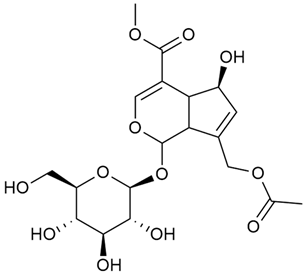 | Hepatoprotective | [47] |
| 31 | Deacetylasperulosidic acid | C16H22O11 | 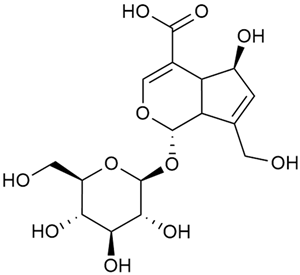 | [46,47] | |
| 32 | Deacetylasperuloside | C16H20O10 |  | [48] | |
| 33 | Geniposidic acid | C16H22O10 |  | [44,45] | |
| 34 | Loganin | C17H26O10 | 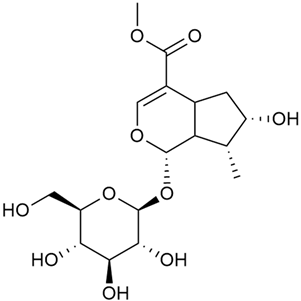 | [46] | |
| 35 | Monotropein | C16H22O11 |  | [46,47] | |
| 36 | Scandoside | C16H22O11 | 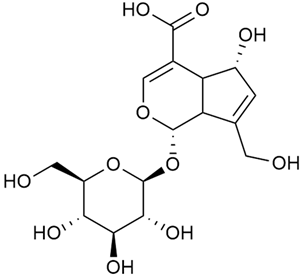 | [46,48] | |
| Anthraquinones | |||||
| 37 | Physcion | C16H12O5 | 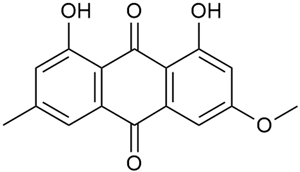 | [53] | |
| 38 | Rubiadin (1,3-dihydroxy-2-methylanthraquinone) | C16H12O5 |  | [53] | |
| Terpenoids | |||||
| 39 | α-Terpineol | C10H18O | 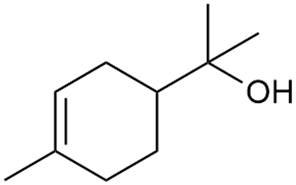 | [56,58] | |
| 40 | Betulalbuside A | C16H28O7 | 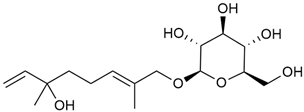 | [47] | |
| 41 | Betulin | C30H50O2 | 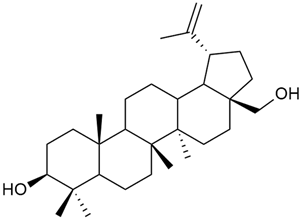 | [57] | |
| 42 | Borneol | C10H18O | 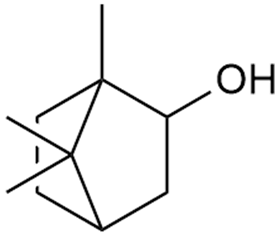 | [56,58] | |
| 43 | Camphor | C10H16O | 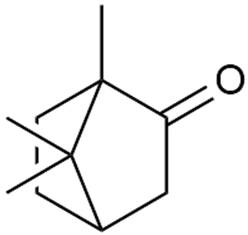 | Antioxidant Cytotoxic Antimicrobial | [56,59] |
| 44 | Euscaphic acid | C30H48O5 | 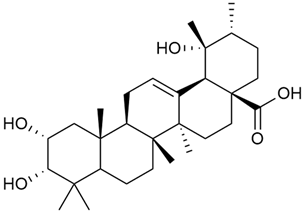 | [57] | |
| 45 | Germacrene D | C15H24 |  | Antioxidant Antimicrobial | [58] |
| 46 | Lupeol | C30H50O | 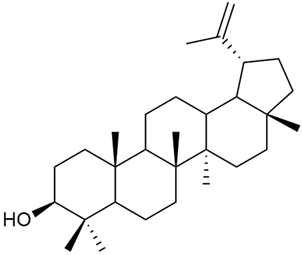 | [57] | |
| 47 | Oleanolic acid | C30H48O3 |  | [57] | |
| 48 | Rubifolic acid | C30H48O4 | 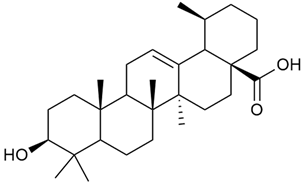 | [18,32] | |
| 49 | Squalene | C30H50 |  | Antioxidant Cytotoxic Antimicrobial | [56,58,59] |
| 50 | Tormentic acid | C30H48O5 | 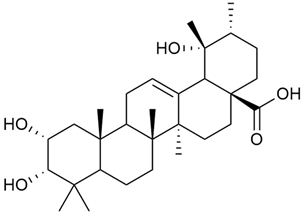 | [57] | |
| 51 | Ursolic acid | C30H48O3 |  | [18,32,57] | |
| 52 | Uvaol | C30H50O2 |  | [57] | |
| Phytosterols | |||||
| 53 | β-sitosterol | C29H50O |  | Antioxidant Anticancer Anti-inflammatory | [62] |
| 54 | Campesterol | C28H48O | 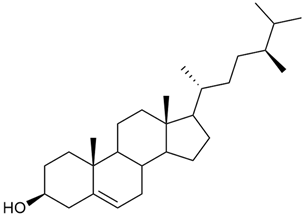 | Anticancer | [61,62] |
| 55 | Stigmasterol | C29H48O | 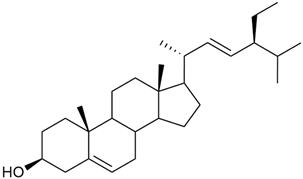 | [61] | |
Disclaimer/Publisher’s Note: The statements, opinions and data contained in all publications are solely those of the individual author(s) and contributor(s) and not of MDPI and/or the editor(s). MDPI and/or the editor(s) disclaim responsibility for any injury to people or property resulting from any ideas, methods, instructions or products referred to in the content. |
© 2025 by the authors. Licensee MDPI, Basel, Switzerland. This article is an open access article distributed under the terms and conditions of the Creative Commons Attribution (CC BY) license (https://creativecommons.org/licenses/by/4.0/).
Share and Cite
Petkova, M.K.; Grozeva, N.H.; Tzanova, M.T.; Todorova, M.H. A Review of Phytochemical and Pharmacological Studies on Galium verum L., Rubiaceae. Molecules 2025, 30, 1856. https://doi.org/10.3390/molecules30081856
Petkova MK, Grozeva NH, Tzanova MT, Todorova MH. A Review of Phytochemical and Pharmacological Studies on Galium verum L., Rubiaceae. Molecules. 2025; 30(8):1856. https://doi.org/10.3390/molecules30081856
Chicago/Turabian StylePetkova, Margarita Koleva, Neli Hristova Grozeva, Milena Tankova Tzanova, and Mima Hristova Todorova. 2025. "A Review of Phytochemical and Pharmacological Studies on Galium verum L., Rubiaceae" Molecules 30, no. 8: 1856. https://doi.org/10.3390/molecules30081856
APA StylePetkova, M. K., Grozeva, N. H., Tzanova, M. T., & Todorova, M. H. (2025). A Review of Phytochemical and Pharmacological Studies on Galium verum L., Rubiaceae. Molecules, 30(8), 1856. https://doi.org/10.3390/molecules30081856










